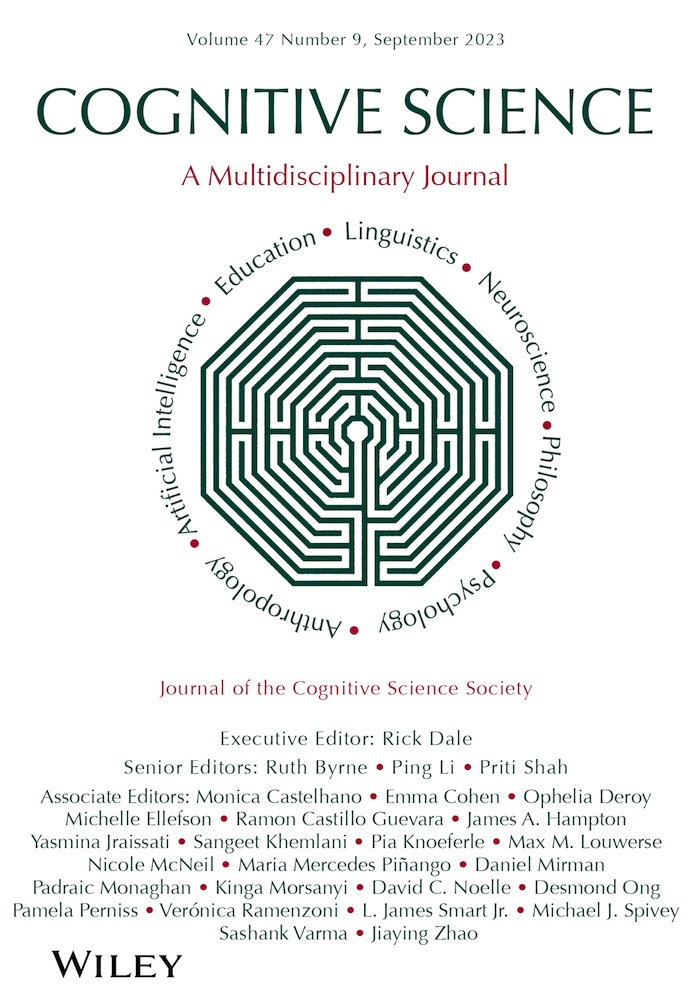An Agent-First Preference in a Patient-First Language During Sentence Comprehension
Abstract
The language comprehension system preferentially assumes that agents come first during incremental processing. While this might reflect a biologically fixed bias, shared with other domains and other species, the evidence is limited to languages that place agents first, and so the bias could also be learned from usage frequency. Here, we probe the bias with electroencephalography (EEG) in Äiwoo, a language that by default places patients first, but where sentence-initial nouns are still locally ambiguous between patient or agent roles. Comprehenders transiently interpreted nonhuman nouns as patients, eliciting a negativity when disambiguation was toward the less common agent-initial order. By contrast and against frequencies, human nouns were transiently interpreted as agents, eliciting an N400-like negativity when the disambiguation was toward patient-initial order. Consistent with the notion of a fixed property, the agent bias is robust against usage frequency for human referents. However, this bias can be reversed by frequency experience for nonhuman referents.
1 Introduction
Comprehending sentences is an incremental process. We tend to immediately interpret each element of an incoming sentence and try to integrate it into the representation that we have already built up (cf., e.g., Altmann & Steedman, 1988; Frazier & Rayner, 1982; Knoeferle, Crocker, Scheepers, & Pickering, 2005; Marslen-Wilson, 1973; Stabler, 1994). This process often occurs in the face of ambiguity and incomplete information. For example, when a reader or listener encounters “the girl” at the beginning of a sentence, there are several possible continuations, such as “…sleeps,” “…eats an apple,” or “…is pushed by the boy.” The initial noun phrase gives no clue that immediately reveals its role in the sentence. Only later on can the comprehension system assess whether the ambiguous noun phrase was the sole argument of an intransitive verb (“sleep”), an agent argument (“eat”) of a transitive verb, or the patient (“be pushed”) argument of a passive.1 Nevertheless, comprehenders routinely assign a role to each noun phrase as it is encountered. In this process, they exhibit a tendency to assume that ambiguous noun phrases are agents. This tendency has been coined the agent (or “subject”) preference and has been shown to operate in a range of spoken languages and also in one signed language (Bader & Meng, 1999; Dröge et al., 2020; Frazier, 1987; Friederici, Mecklinger, Spencer, Steinhauer, & Donchin, 2001; Haupt, Schlesewsky, Roehm, Friederici, & Bornkessel-Schlesewsky, 2008; Krebs, Malaia, Wilbur, & Roehm, 2018; Jackson, Lorimor, & Van Hell, 2020; Mecklinger, Schriefers, Steinhauer, & Friederici, 1995; Meng & Bader, 2021; Schlesewsky, Fanselow, Kliegl, & Krems, 2000; Schriefers, Friederici, & Kühn, 1995).
1.1 The agent preference in sentence comprehension
- (1)
a. …dassBertramSurferinnen
thatBertramsurfer.FEM.PL
geärgerthat.
- annoyedAUX.SG
- “…that Bertram annoyed surfers.”
-
b. …dassBertramSurferinnen
thatBertramsurfer.FEM.PL
- geärgerthaben.
- annoyedAUX.PL
- “…that surfers annoyed Bertram.”
Haupt et al. (2008, 60)
The unexpected status of patient-agent orders is confirmed by longer reading times (Schlesewsky et al., 2000) and ERP differences and slower reactions in acceptability ratings (Bornkessel, McElree, Schlesewsky, & Friederici, 2004; Haupt et al., 2008).
The preference for interpreting initial noun phrases as agents also generalizes over their semantic properties, such as the contrast between proper names and common nouns (Kretzschmar, Bornkessel-Schlesewsky, Staub, Roehm, & Schlesewsky, 2012). Although later ERP components show sensitivity to some of these modulations, the N400 effect persists in all sentence types, suggesting that comprehenders always follow an agent-first preference in German (Dröge et al., 2020).
- (2) a. Dünadamgördüm.
- yesterdaymansee.PST.1SG
- “I saw (a) man yesterday.”
- b. Düntaşgördüm.
- yesterdaystonesee.PST.1SG
- “I saw (a) stone yesterday.”
Turkish, Demiral et al. (2008, 487)
A similar effect was found in Mandarin Chinese, where patient disambiguations of unmarked initial noun phrases also triggered ERP effects, even when they referred to an inanimate object and a patient-initial reading is the most natural and plausible one offline (e.g., xiǎoshuō yuèdúle ‘novel read’, i.e., ‘(I/you/s/he/someone) read the novel’; Wang, Schlesewsky, Bickel, & Bornkessel-Schlesewsky, 2009).
The agent preference effect was also replicated in Hindi, where initial noun phrases are also commonly patients. Again, unmarked initial noun phrases were preferentially assumed to be agents even when denoting inanimate referents. When this assumption was contradicted by the verb, this again triggered an N400 effect (Bickel, Witzlack-Makarevich, Choudhary, Schlesewsky, & Bornkessel-Schlesewsky, 2015; Choudhary, 2010). Intriguingly, the effect was not mitigated in Hindi by the fact that under specific, but frequent syntactic conditions, unmarked noun phrases default to a patient reading because agents receive a special case marker (known as “ergative”). Thus, the agent preference persists even when the rules of grammar favor a patient reading of unmarked noun phrases.
Together, these findings suggest that the agent preference is a cross-linguistically robust principle of sentence comprehension, following from the central role that agents play in general event perception and cognition. This central role is likely rooted in an evolutionarily old bias to detect and attend to agentive features, as it is found in great apes and many other species (e.g., in great apes' ability to assign agency to infer the goal of grasping actions, Kano & Call, 2014, see Wilson, Zuberbühler, & Bickel, 2022; Zuberbühler & Bickel, 2022 for reviews). Agents can be rapidly extracted from event depictions (Dobel, Gumnior, Bölte, & Zwitserlood, 2007; Gerwien & Flecken, 2016; Sauppe & Flecken, 2021), already in early infancy (Galazka & Nyström, 2016; Johnson, 2003). Agents also receive preferential attention, for example, when viewing pictures for description (Sauppe et al., 2021; Webb, Knott, & MacAskill, 2010; Norcliffe & Konopka, 2015; Isasi-Isasmendi et al., 2023). Agents are furthermore central to the comprehension of unambiguous sentences and are, for example, anticipated earlier than patients in the processing of verb-initial languages (Sauppe, 2016).
An alternative possibility, however, is that the agent preference is a processing principle that is derived from expectations based on learning and experience with how language is used in communication. The most frequent word order in each language studied so far is agent-initial (cf. Dryer, 2013). While, as noted, sentences in languages, such as Turkish, Mandarin Chinese, or Hindi, frequently start with patients because agents are omitted, agents are preferentially placed first when they are expressed. Thus, the agent preference could be learned from these agent-initial sentences.
There is evidence that experience can indeed modulate the incremental interpretation of role-ambiguous noun phrases. For example, when listening to a speaker who uses more unambiguous patient-agent than agent-patient word orders, comprehension processes can adapt to this tendency so that disambiguations toward patient-agent orders become less unexpected (Kroczek & Gunter, 2021). Pointing in the same direction, patient-initial sentences in Finnish are read faster if the previous discourse context has already introduced the patient referent as given, setting up readers' expectations for such a word order (Kaiser & Trueswell, 2004).
On a more general note, the frequency of different structures and words in a language is known to drive comprehenders' expectations when they predict the upcoming (lexical) input (Frank, Otten, Galli, & Vigliocco, 2015; Levy, 2008; Demberg & Keller, 2008). This is consistent with an account under which comprehenders build their interpretations of role-ambiguous noun phrases solely based on their learned expectations. The account seems parsimonious because only linguistic experience is needed to explain the parsing preferences (Hörberg & Jaeger, 2021; Traxler, 2014).
Whether the agent preference is a general principle or emerges through experience with agent-initial orders can be answered by turning to a language that regularly puts patients before agents. Here, we present an experiment on sentence comprehension in Äiwoo (spoken in Solomon Islands), a language with patient-verb-agent (PVA, also often referred to as “OVS”) as its basic order, in the sense that, as we will show, the PVA order is most frequently used and the default choice across contexts, and that it is the order with the simplest phrase structure ([P [V A]], the mirror image of the basic [A [V P]] phrase structure in English). In this language, agent-first structures are not a viable default and so listeners are more likely to expect that initial noun phrases are patients than agents. Therefore, if preferences for how to interpret role-ambiguous noun phrases derive from linguistic experience, Äiwoo should exhibit a preference for patients. By contrast, if role assignment follows a general principle, the agent preference should persist in Äiwoo.
1.2 The order of agents and patients in Äiwoo
Äiwoo2 belongs to the Oceanic branch of the Austronesian language family (Ross & Næss, 2007). The language is spoken primarily in the Reef Islands in Solomon Islands' Temotu province, in the southwest Pacific Ocean (Fig. 1), as well as in settlements in the country's capital, Honiara.

- (3)
- a. viliku-guwa-vilengätebol
- parrotIPFV-jump.INTR-aroundLOCtable
- “The parrot was jumping around on the table.”
- b. viliku-wâ-waabo-nâgilakigonä-meloo
- parrotIPFV-CAUS-tame-PVboyso_thatIRR-calm
- “The boy stroked the parrot to calm it.”
- c. viliki-mapokeetevingänyenaa
- parrotIPFV-nibble.AVtevi_fruitLOCtree
- “The parrot was nibbling on a tevi fruit in the tree.”5
When comprehenders encounter vili “parrot” in (3), it could be the sole argument of an intransitive verb (e.g., “jump around,” 3a), the patient argument of a patient-voice (PV) verb (e.g., “stroke,” 3b), or the agent argument of an agent-voice (AV) verb (e.g., “nibble,” 3c). Comprehenders can use the verb to disambiguate the role of the sentence-initial noun by using information about the verb's valency (i.e., whether it describes a one-participant or two-participant event), lexically encoded information (such as verb class), and voice marking.
To some extent, the difference between agent and patient voice is comparable to the difference between active and passive voice in English (“The boy strokes the parrot” vs. “The parrot is stroked by the boy”). Crucially, however, the Äiwoo patient voice, and therefore PVA order, is syntactically more basic and the default choice, while in English, the active voice is more basic and more common. Two lines of evidence support this.
- (4)
- a. [VP ki-ngäsime]=tongâsâpulâu=kâ
- IPFV-eat.PVperson=nowLOCmen's_house=DIST
- “‘People eat in the men's house.”
- b. kâ-no=ngä[VP nyä-vängä]=to[sii]=kâ
- want-1SG=CV1MIN.IRR-eat.AV=nowfish=DIST
- “I want to eat fish.”6
Second, verbs are used more frequently in the patient voice than in the agent voice in Äiwoo. Previous corpus studies found that patient voice is up to seven times more frequent in spoken Äiwoo (Holmen, 2020). Agent voice is limited to a number of contexts relating to the syntactic or discourse prominence of the agent, including when the agent is relativized on or focused, and when the action itself (rather than its effect on the patient) is being focused or emphasized (Næss, 2015a), and it appears to be associated with the introduction of new participants into the discourse (Holmen, 2020). Thus, agent voice sentences are nondefault in that they require more specific contexts for their use. In contrast, patient voice sentences do not have special contextual and information-structural requirements.
Given its default status and high frequency, the patient voice gives rise to many opportunities for patient-initial sentences (as in example 3b). At the same time, noun phrases can be freely omitted, so that many sentences might not start with a noun phrase but with a verb. Therefore, the higher frequency of the patient voice verbs does not necessarily translate into a higher frequency of initial patient noun phrases. Rather, to estimate the frequency-based expectations that comprehenders bring to initial noun phrases, it is necessary to estimate their role probabilities directly.
In what follows, we corroborate earlier estimates of these probabilities (Næss, 2015a, 2021) with a corpus analysis. We analyzed all digitally available, transcribed texts (Næss, 2017) and annotated the role of preverbal arguments in them. The corpus consists mainly of monological narrative texts () ranging in length from 82 to 8079 words (994 words on average, 71,636 in total). All texts have morpheme-by-morpheme glossing, allowing us to determine each verb's voice marking, and thus the role of its noun phrase arguments.7
For each clause, we annotated whether one of the core argument noun phrases (transitive agents and patients, or sole arguments of intransitive verbs) occurred before the verbal predicate (i.e., in clause- or sentence-initial position). Arguments that were dropped or omitted were not counted because they are uninformative about how listeners interpret initial noun phrases and because they do not reflect syntactic movement into another position, but rather speakers’ various discourse needs. Preverbal noun phrase arguments were coded as referring to intransitive sole arguments, transitive verbs' agents or patients, or other (or not identifiable) roles. In the case of coordinated clauses in which the argument in the second clause was elided (such as in, e.g., “The mani came into the room and sat down”), only the first clause's argument was treated as overtly realized noun phrase, and the second clause was coded as having an omitted argument. Externally headed relative clauses were also coded as having omitted arguments. For coordinated noun phrases, we counted all nouns as individual, preverbally overt arguments because each of them was role-ambiguous by itself.
Fig. 2 shows the raw frequencies of roles in our corpus. The majority of preverbal noun phrases denotes the sole argument of an intransitive verb. At the same time, preverbal patient arguments are more frequent than preverbal agent arguments, regardless of whether the arguments refer to humans, animates (animals), or inanimate entities.
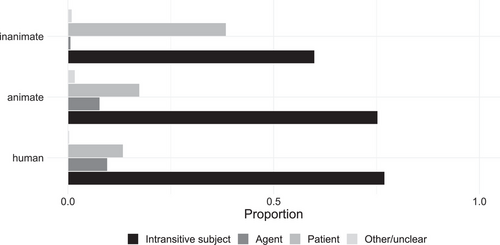
In order to estimate the uncertainty and variability of these frequency counts, we fitted hierarchical Bayesian Bernoulli models of the role of preverbal noun phrases with transitive verbs (agent or patient). This quantifies the strength of belief Äiwoo speakers may have regarding which role disambiguation is more likely.
In addition, we modeled the probability that a sentence is disambiguated toward being intransitive or transitive by the verb, so that the preverbal noun phrase turns out to be the sole argument of an intransitive verb, or a transitive verb's agent or patient. This quantifies Äiwoo speakers' belief about whether to even expect (transitive) patient or agent disambiguation, as opposed to expecting a single-argument intransitive sentence.
Both models condition on animacy, coded as a three-level factor encompassing human, animate (animal/nonhuman), and inanimate referents, as this is well known to affect role coding in grammars (e.g., Silverstein, 1976; Bickel, 2010; Dowty, 1991) and expectations during comprehension (e.g., Bornkessel-Schlesewsky & Schlesewsky, 2009b). The same categories are used in the sentence comprehension experiment described below. We included random intercepts (group-level effects) for the identity of the head noun (i.e., its lemma) in order to capture lexical variation, and random intercepts for the text from which an observation stemmed in order to capture speaker and context variation. We fit the models with the brms interface to Stan (Carpenter et al., 2017; Bürkner, 2017, 2018), using normally distributed priors for the intercept and the animacy variable () and exponentially distributed priors for group-level effects ().
Fig. 3a shows the posterior probabilities for the annotated nouns being patients. While probabilities increase from human to animate to inanimate referents, a patient interpretation is decisively more probable than an agent interpretation in all three categories. Over 95% of the probability mass lies to the right of 50%, that is, the chance level. Fig. 3b shows the posterior probabilities for sentences to turn out to be transitive or intransitive when encountering the verb. For all three animacy types, intransitive sentences are decisively more probable, so that the preverbal noun is the sole argument of the verb. Again, over 95% of the probability mass excludes the chance level.
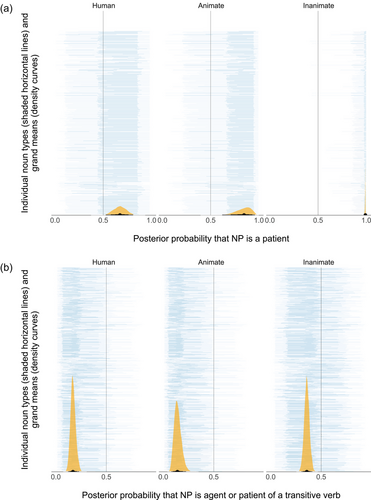
Although the corpus used here is limited in size and variation, these findings are consistent with the notion that SV and PVA orders are not only the dominant pattern in syntactic rules but that they are also the default choice in usage. It is in this sense that Äiwoo is indeed a patient-initial language.
1.3 The current sentence comprehension study
We test the agent preference in Äiwoo by measuring ERP responses when verbs disambiguate the role of an initial noun phrase (Table 1). If comprehension is based on a general principle of agent preference, role-disambiguating verbs should elicit similar ERP effects as in the other languages studied so far. Thus, even though the patient role is the default and most probable interpretation of an initial noun phrase in Äiwoo when the verb is transitive (Fig. 3a), the parser should prefer to interpret it as an agent or sole argument of an intransitive verb. Disambiguations toward a patient interpretation should elicit an ERP response that reflects this preference. By contrast, if the interpretation of ambiguous noun phrases is driven by experience with the patterns of language use, we expect the comprehension system to adapt to Äiwoo. Under this account, disambiguations toward agent-initial orders should elicit an ERP response that reflects a preferential assignment of patient or sole argument interpretations, unlike in the other languages studied so far.
| Comprehension driven by… | Prediction | Expected ERP effct |
|---|---|---|
| General agent preference | Role-ambiguous NPs interpreted | N400/LAN for disambiguations |
| as agents or sole arguments | toward patient readings | |
| Linguistic experience | Role-ambiguous NPs interpreted as | N400/LAN for disambiguations |
| patients or sole arguments | toward agent readings |
Previous studies on role disambiguation suggest that the detection of a mismatch between the disambiguating verb and the transient interpretation of the initial noun phrases is reflected mainly in an N400 (Bickel et al., 2015; Wang et al., 2009; Mecklinger et al., 1995; Haupt et al., 2008). Some of these studies report biphasic ERP patterns, with a late positivity following the N400 (Bickel et al., 2015; Haupt et al., 2008). Therefore, we focus our analysis on the corresponding time windows, ranging 300–500 ms and 600–900 ms after verb onset. However, activity in the second time window did not turn out to be functionally distinct from the N400 effects.
As Äiwoo is rarely used in writing, we presented stimulus sentences auditorily. N400 components for auditorily presented stimuli are known to sometimes have a more frontal distribution, which can make them difficult to distinguish from left-anterior negativities (LANs). Therefore, we refer to the 300–500 ms window as the N400/LAN time window. Overall, it is the presence of any predicted ERP correlate of mismatch detection as an index of the revision of a transient interpretation that is of central interest.
Although previous work suggests the agent preference is robust against variations in animacy (Bickel et al., 2015; Demiral et al., 2008; Wang et al., 2009), there are notable differences in the probabilities of specific roles (Figs. 2 and 3a). In response, we manipulated this factor in the role-ambiguous nouns. This makes it possible to test whether the parser assigns different weights to agent or patient interpretations based on animacy, which would be reflected in N400 and P600 differences (Brouwer, Delogu, Venhuizen, & Crocker, 2021; Rabovsky, Hansen, & McClelland, 2018; Kuperberg, Caplan, Sitnikova, Eddy, & Holcomb, 2006).
2 Methods
2.1 Participants
Twenty-three native speakers of Äiwoo (9 female, age: mean = 33.5 years, range = [19, 60] years) were recruited through newspaper, radio, television reports, and word of mouth in Honiara, Solomon Islands. Participants were compensated with SBD 50 (approximately EUR 5.50). Twenty-two participants were right-handed and one was ambidextrous, as determined by a version of the Edinburgh handedness inventory translated into Solomon Islands Pijin (Oldfield, 1971). All participants reported that they used Äiwoo as their primary language and that they grew up speaking the language to both their parents. (Data from four additional participants were excluded due to technical problems during data collection.) Each participant gave their informed oral consent (in Solomon Islands Pijin), which was recorded on audio. The study was approved by the Solomon Islands Ministry of Education, Human Resources and Development, and ethical integrity was certified by the Ethics Committee of the Canton of Zurich (Req-2017-00425).
2.2 Materials
Thirty-six sets of Äiwoo sentences of the form [NP1 V (NP2) Final part] were constructed. Each set consisted of three sentences starting with the same human, animate, or inanimate noun in the NP1 position, which was resolved toward an intransitive subject, agent, or patient reading by the morphological form of the verb. For disambiguations toward agent or patient readings, the transitive verbs were followed by their second arguments (NP2). Intransitive sentences included only one noun phrase. The sentences concluded with an adjunct or prepositional phrase. Twelve sets each started with human, animate, or inanimate nouns, yielding 108 critical sentences in total. Table 2 provides an example set for each animacy category. Fifty-four filler sentences that started with temporal adverbs, locative phrases, verbal predicates, or adverbial clauses were also constructed.
| Animacy | Role | ||||
|---|---|---|---|---|---|
| of NP1 | of NP1 | NP1 | V | NP2 | Final part |
| inanimate | A | Tevagolâ | itogo | nyiivä | ngä nelo |
| canoe | strike.AV | rock | in the sea | ||
| “The canoe struck a rock in the sea.” | |||||
| P | Tevagolâ | kikäiee | sigiläi | ngä nyike nelo | |
| canoe | pull.PV | man | on the beach | ||
| “The man pulled the canoe up on the beach.” | |||||
| S | Tevagolâ | iluwo | go bopolâ | ||
| canoe | sink.INTR | because have_hole | |||
| “The canoe sank because it had a hole.” | |||||
| animate | A | Nulei | kikei | numobâ | ngä nyike nelo |
| crab | dig.AV | hole | on the beach | ||
| “The crab dug holes on the beach.” | |||||
| P | Nulei | ipägulo | dowâlili | ngä nye | |
| crab | burn.PV | child | on the fire | ||
| “The child burned a crab on the fire.” | |||||
| S | Nulei | kieli | ngä nelo | ||
| crab | crawl.INTR | in the sea | |||
| “The crab crawls in the sea.” | |||||
| human | A | Ibe | iwoi | nulie | ngä paveli tä |
| old_man | plant.AV | pana | in garden his | ||
| “The old man planted pana (lesser yam) in his garden.” | |||||
| P | Ibe | kupubii | gilaki | ngâ nuumä tä | |
| old_man | follow.PV | boy | to village his | ||
| “The boy followed the old man to his village.” | |||||
| S | Ibe | imo | ngâ nuwopa tä | ||
| old_man | stay.INTR | in house his | |||
| “The old man stayed in his house.” | |||||
- Abbreviations: A, agent; AV, agent voice; INTR, intransitive; P, patient; PV, patient voice; S, sole argument of an intransitive verb.
The arguments used in the sets of critical sentences consisted of a single noun with a general meaning (e.g., “old man,” “child,” “crab,” “dog,” “canoe,” or “arrow”).8 We classified these into the categories “inanimate,” “animate,” and “human” based on the familiarity that one of us has with Äiwoo culture and daily life from linguistic fieldwork. The verbs used in the critical sentences were drawn from common semantic types of verbs, including perception verbs (e.g., “see,” “hear”), verbs of change of state (e.g., “break,” “chop”), verbs of production (e.g., “build,” “carve”), and verbs of motion and change of location (e.g., “pass,” “pour,” cf. Table 29). All selected verbs entail a clear difference between an agent and a patient in the sense of proto-roles (Dowty, 1991), macro-roles (Foley & Van Valin, 1984), or generalized semantic roles (Bickel, 2010).
Although wrap-up effects are an unlikely concern for comprehension processes (Stowe, Kaan, Sabourin, & Taylor, 2018), we included more words (mainly locative phrases and other adjuncts) after the verb or NP2 to avoid any potential wrap-up effects, especially when the critical word (the verb) would otherwise have been sentence-final in intransitive sentences.
To keep listeners attention, one-third of the trials were paired with a comprehension question posed immediately after the playback of the sentence ended. The comprehension questions aimed at the identity of NP1, NP2, or the verb, or asked about the final segment of the sentence (e.g., “Did the old man plant lesser yam on the beach?” following the human/agent sentence, “Was it a shell the child burned?” following the animate/patient sentence, or “Did the canoe sink because it had a hole in it?” following the inanimate/intransitive subject sentence in Table 2).
The stimulus sentences were recorded from a female native speaker of Äiwoo in a natural pace and with prosodically unmarked intonation, who also confirmed the acceptability of the stimulus sentences (during debriefing, also none of the participants reported issues with the acceptability and naturalness of the materials).
2.3 Apparatus and procedure
Participants were tested individually, seated in front of a laptop computer in a quiet, air-conditioned room that was transformed into an ad hoc electroencephalography (EEG) laboratory (S.S. and Å.N. were present in the same room during the entire session). The experiment was controlled by E-Prime 2.0 (Schneider, Eschman, & Zuccolotto, 2002) on Microsoft Windows 10.
Stimulus sentences were presented auditorily through a set of in-ear headphones. The order of trials was randomized separately for each participant. Participants' task was to listen carefully to the stimulus sentences and to answer the comprehension questions with “yes/no” responses by a left or right button press on a Cedrus RB-844 response pad (Cedrus Corporation, San Pedro, USA). The association of left/right buttons and “yes/no” answers was counterbalanced across participants.
Participants first received oral instructions before completing nine practice trials with feedback on the accuracy of their response. After the practice phase, no further feedback was given, except for reminders to remain sitting still and to avoid blinking while hearing the stimulus sentences. Participants proceeded through the experiment in a self-paced manner by initiating each trial with a button press and were offered a break after each block of 27 trials.
Trials began with the presentation of a picture of the response pad (serving as “fixation cross”) until the participants pressed a button. Auditory stimulus sentence presentation followed, and a drawing of an ear was displayed to signal that participants should listen carefully. After a blank screen of 1500 ms, either the next trial started with the response box picture or the ear drawing was presented again if the sentence was followed by a comprehension question (also presented auditorily). After presentation of the comprehension question, two boxes labeled “yes” and “no” and colored blue and yellow, respectively, were shown to prompt the participants to answer by pressing the corresponding button of the same color on the response pad.
2.4 EEG recording and preprocessing
Electrophysiological activity was recorded with an Enobio 32 EEG (Neuroelectrics Inc., Barcelona), using the manufacturer's NIC 2.0 software, at a sampling rate of 500 Hz. Data were recorded on a separate computer from the computer that controlled the presentation of the experiment. Twenty-seven Enobio Geltrode electrodes (4 mm Ag/AgCl sintered) were placed on the scalp in a 10–20 montage (Fig. 4). One electrode each was placed on the left and right mastoid bones and three additional electrodes recorded the electrooculogram (EOG, placed on the outer right canthus, and below and above the right eye). The NIC software assesses the quality of the recording through a “quality index” (Neuroelectrics User Manual, 2017, 42–43) and all electrodes were kept below a 0.5 threshold throughout the recordings.
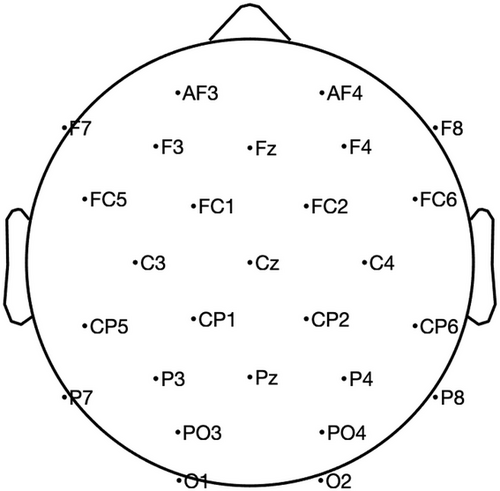
EEG data were preprocessed with EEGLAB (Delorme & Makeig, 2004) and ERPLAB (Lopez-Calderon & Luck, 2014). The data were bandpass filtered between 0.16 and 30 Hz to remove slow signal drifts and high-frequency noise, subsequently downsampled to 250 Hz and re-referenced offline to the average of the left and right mastoid electrodes (T9 and T10). Particularly noisy channels were rejected (defined as deviating more than 5 SD from all other channels in either kurtosis or data probability) and independent components were computed on a 1 Hz high-pass-filtered copy of the data. Independent components reflecting artifactual activity were identified with automatic heuristics: FASTER detected contaminated channels, eye movement and electromyographic artifacts, linear trends, and white noise (Nolan, Whelan, & Reilly, 2010); SASICA also identified components that were focal to individual electrodes (also indicating contamination) and components that were highly correlated with EOG activity (Chaumon, Bishop, & Busch, 2015). Previously rejected channels were then spherically interpolated.
Epochs were extracted from –200 to 1000 ms relative to verb onset. Onsets in the audio recordings were independently annotated in Praat (Boersma, 2001) by three raters (S.S. and two phonetically trained raters that were naïve about Äiwoo and the purpose of the study).10 No baseline correction was applied for analyses; rather, the median amplitude between –200 and 0 ms was included as a covariate in regression models (Alday, 2019).
Epoch-wise interpolation of channels exhibiting amplitudes exceeding ±100 μV was performed (Ben-Shachar, 2020) and epochs in which more than six channels had to be interpolated were excluded. The agent condition from one item was excluded from analyses because erroneously an intransitive sentence was presented. On balance, 2423 epochs (97.5% of all epochs) were included in the analyses.
2.5 Analyses
Based on visual inspection of the event-related potentials (ERPs) and our expectations derived from the literature, we selected two time windows that exhibit activity typically associated with syntactic reanalysis processes (Swaab, Ledoux, Camblin, & Boudewyn, 2011; Kaan, 2007). The first window ranged from 300 to 500 ms relative to the disambiguating verb's onset, to cover the N400 and LAN (left-anterior negativity) components. The second window ranged from 600 to 900 ms relative to the onset of the verb, which we refer to as “Late Window.” The results do not indicate a separate function for this time window; rather, it reflects sustained activity from the N400/LAN time window. The topography and timing of ERPs in response to auditory sentence stimuli may also differ from visual ERPs during reading (see Kyriaki, Schlesewsky, & Bornkessel-Schlesewsky, 2020, for a recent discussion). Therefore, we abstain from associating the “Late Window” with a specific ERP.
We analyzed the mean amplitudes of the event-related potentials for these time windows at the single trial level (Stokes & Spaak, 2016; Frömer, Maier, & Abdel Rahman, 2018; Vossen, Van Breukelen, Hermens, Van Os, & Lousberg, 2011; Volpert-Esmond, Page-Gould, & Bartholow, 2021; Volpert-Esmond, Merkle, Levsen, Ito, & Bartholow, 2018) with generalized additive mixed effects regression models (GAMM) using the package mgcv (Wood, 2011, 2017, 2004) in R (R Core Team, 2023). GAMM visualizations were created with the package itsadug (van Rij, Wieling, Baayen, & van Rijn, 2020).
GAMMs are an extension of generalized linear regression and allow the modeling of nonlinear relationships between variables. This is especially useful for the analysis of nonlinearly varying neurophysiological data over space and time, such as event-related potentials (De Cat, Klepousniotou, & Baayen, 2015; Tremblay & Newman, 2015). The mean amplitudes in each analysis time window are modeled as a function of electrode position (in a two-dimensional coordinate system) and sentence type, yielding “wiggly” surfaces (tensors) that reflect ERP topographies. This approach does not require the grouping of electrodes into regions of interest and the dynamic variation in the full spatial extent of ERP effects can be modeled without averaging over electrode positions. In addition, GAMMs account for the hierarchical structure of the data by allowing random effects.
We model the interaction of the noun's role and its animacy by way of six-level factors that combine both role and animacy in a single categorical variable (human-agent, animate-agent, inanimate-agent, human-patient, animate-patient, inanimate-patient for the analyses on disambiguations toward agent vs. patient and human-intransitive, animate-intransitive, inanimate-intransitive, human-transitive, animate-transitive, inanimate-transitive for the analyses on disambiguations toward intransitive vs. transitive sentences). In comparisons of disambiguations toward intransitive and transitive sentences, the transitives encompassed both agent-initial and patient-initial sentences. We include additional predictors to account for partial nuisance effects (Sassenhagen & Alday, 2016). Specifically, we include main effects of age and level of education (primary, secondary, or tertiary education) as well as tensors of electrode position and each predictor. Education levels are a proxy measure for literacy (in English and Pijin, as Äiwoo is a primarily spoken language), which can affect individuals' sentence comprehension strategies (e.g., Huettig, Singh, & Mishra, 2011; Huettig & Pickering, 2019). Furthermore, we include a main effect of trial number to capture the general changes in ERP amplitudes during the experiment and the median amplitude between –200 and 0 ms for each electrode and trial to account for baseline differences (cf. above, Alday, 2019). We fit random slopes for electrode position by participants and by sentence. Continuous predictors were mean-centered and categorical predictors were treatment-coded (cf. Tables S2–S5 for predictor reference levels).
We used backward model comparison to assess the joint statistical significance of the tensors involving electrode position and the interaction of noun animacy and semantic role disambiguation type, as well as of the respective main effects. For model comparison, we rely on omnibus F-tests and AIC differences, contrasting models with and without the predictors of interest. We determine the statistical significance of contrasts between individual levels of animacy and role disambiguation by pairwise comparisons of the sentence types' fitted surfaces (thus including the main effect and the tensor smooth but excluding the effects of all other predictors). If the difference surface exhibits areas in which the simultaneous 95% confidence interval excludes 0 (van Rij, Hendriks, van Rijn, Baayen, & Wood, 2019), two sentence types are taken to elicit significantly different ERPs.
3 Results
The comprehension questions were answered with high accuracy (mean of by-participant means = 90%, SE = 1%, SD = 7%).
3.1 Disambiguation toward agent versus patient
Grand average ERPs time-locked to the onset of the disambiguating verb are shown in Figs. 5-7 for sentences with preverbal human, animate, and inanimate nouns, respectively.
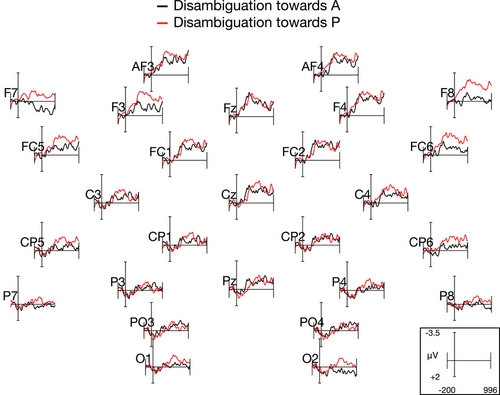
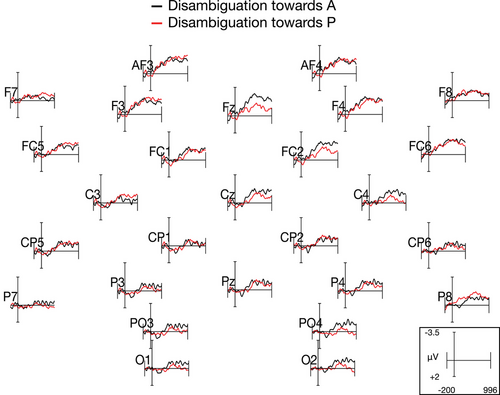
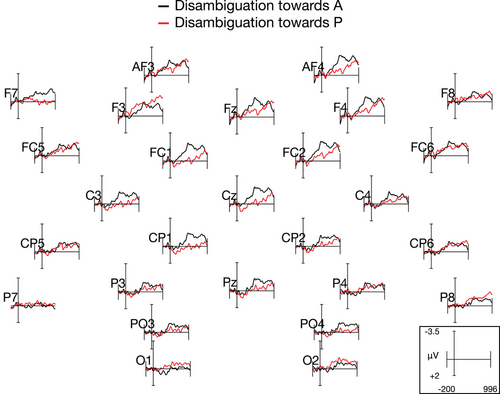
Figs. 8 and 9 show the observed and fitted amplitude differences between sentences with disambiguations toward agent or patient readings for the sentence-initial noun phrase during the N400/LAN time window (300–500 ms after verb onset) and during the later time window (600–900 ms), respectively.
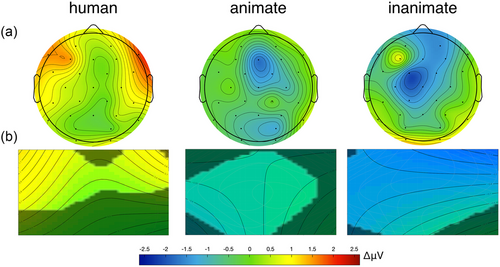
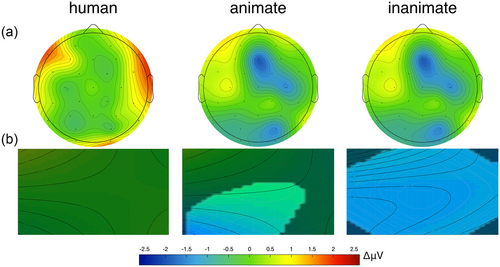
Sentences with human nouns elicited a frontally distributed negativity for disambiguations toward patient readings compared to agent readings during the N400/LAN time window (Figs. 5 and 8). For the later time window, the regression model did not detect differences between disambiguations toward agent or patient readings after human nouns (Fig. 9).
By contrast, sentences starting with animate and inanimate nouns showed a different pattern of ERPs. In both the N400/LAN and the later time window, disambiguations toward agent readings elicited more negative amplitudes than patient disambiguations. These agent-related negativities had a central-posterior topography after animate nouns (Figs. 6, 8, and 9) and a widespread central-anterior topography after inanimate nouns (Figs. 7-9).
The influence of the animacy of the noun phrase on the differences in ERP amplitude and topography between disambiguations toward agent and patient interpretations is demonstrated by tests on model fits. The fit of the model improved for both time windows by including the interaction between animacy and disambiguation compared to a model that only included the main effects of animacy and disambiguation (N400/LAN: , , ; Late Window: , , ).
3.2 Disambiguation toward intransitive versus transitive sentences
Figs. 10-12 show the grand average ERPs time-locked to the onset of the verb when it is resolved to intransitive or transitive interpretations with human, animate, and inanimate preverbal nouns, respectively.
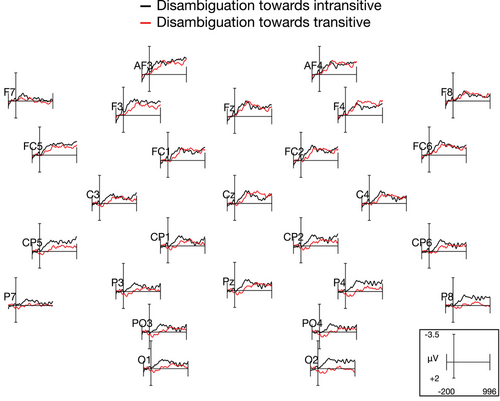
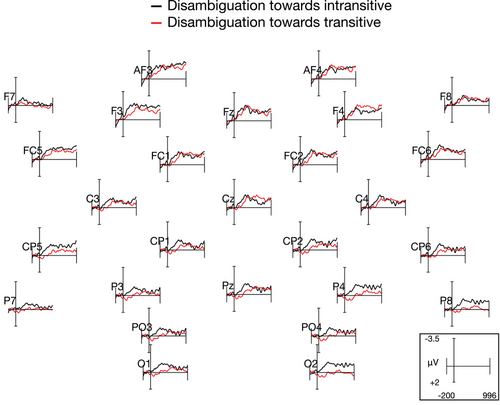
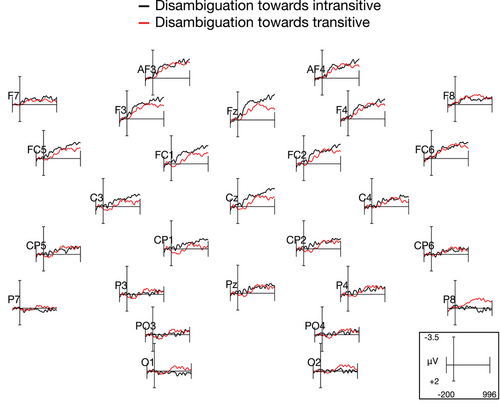
Figs. 13 and 14 show the observed and fitted amplitude differences between intransitive and transitive sentences during the N400/LAN time window (300–500 ms after verb onset) and the later time window (600–900 ms), respectively.
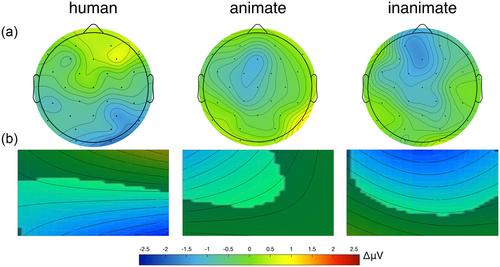
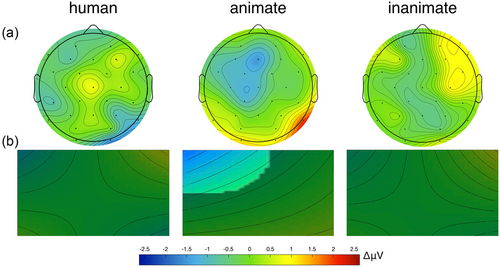
Sentences with intransitive verbs, that is, with disambiguations toward intransitive subject readings of the initial noun phrase, elicited widespread negativities during the N400/LAN time window (Fig. 13) for the three animacy types. Disambiguation toward human intransitive subjects elicited a central-posterior negativity, whereas disambiguation toward animate and inanimate intransitive subjects elicited negativities with central-anterior topographies. Only for animate nouns was this negativity sustained into the late time window (600–900 ms). Neither human nor inanimate nouns exhibited ERP amplitude differences in the late time window for disambiguations toward intransitive verbs compared to transitive verbs.
The influence of animacy on the differences in ERP amplitude and topography between intransitive and transitive verbs during the N400/LAN time window is also demonstrated by tests on model fits. The fit of the N400/LAN model improved by including the interaction between animacy and verb transitivity compared to a model that only included the main effects of animacy and transitivity (N400/LAN: F(8.54) = 4.43, .0001, = 21.58). Tests on the fit of the model for the Late Window revealed that there was no significant interaction between animacy and transitivity (F(9.92) = 0.60, p = .81, although = 13.67 was relatively high). However, there was a significant main effect of animacy for this time window (F(8.45) = 3.93, .0001, = 16.72). The main effect of transitivity did not reach statistical significance (F(4.32) = 2.27, p > .05, = 1.49).
4 Discussion
We presented an ERP experiment to test whether the agent preference is applied as a parsing heuristic for incremental argument interpretation also beyond languages where agents are placed first by default, or whether parsing preferences are rather based on long-term experience with the patterns of language use. For this, we turned to the Oceanic language Äiwoo, where patient-first sentences are the default choice in grammar and decisively more probable than agent-first sentences.
4.1 Expecting agents versus patients
The initial interpretation of ambiguous noun phrases in Äiwoo shows evidence of both an advantage for agents and an advantage for patients in comprehension, lending support to both a general agent preference and an experience-driven patient preference.
For nonhuman noun phrases, the initial parsing preferences followed Äiwoo speakers' experience with basic word order. Noun phrases are more likely to occur as patients than as agents in preverbal positions (Fig. 3a). In line with this, role-ambiguous nonhuman nouns were preferentially interpreted as patients, requiring a revision of their initial parse when the verb disambiguated the noun toward an agent role. This finding is consistent with the hypothesis that the parsing strategy reflects the expectations that comprehenders bring with them from experience with their language (Levy, 2008; Demberg & Keller, 2008; Hörberg & Jaeger, 2021).
For human referents, however, comprehenders preferentially assumed that ambiguous initial noun phrases were agents, triggering an N400/LAN difference when they turn out to be patients when parsing the verb. We observed this effect despite the fact that these noun phrases are decisively more probable to be patients than agents, just like for nonhuman referents. This probability is admittedly weaker (estimated grand mean = .68) than for animate (.83) and inanimate (.98) referents, but it is not reversed (Fig. 3a). Therefore, the difference in expected probabilities cannot explain why the ERP effects are reversed between humans and3 nonhuman referents. This suggests that the agent preference for human referents reflects a general bias and cannot be reduced to the linguistic experience that Äiwoo subjects bring to the task.
The human agent preference can plausibly be attributed to a general and possibly prelinguistic principle of event cognition (Kemmerer, 2012; Wilson et al., 2022). This would mean that it is a fundamental principle of language processing that operates in all languages, independently of their specific affordances, and, as such, shapes language evolution (Bickel et al., 2015). The bias cannot be overridden because the expectations of agency are very strong for human referents (Silverstein, 1976; Dowty, 1991)—even in a language that defaults to a patient-before-agent order.
Consequently, we propose that the patient preference that we found for nonhuman referents is a reversal that only arises under narrow circumstances, namely, when the basic word order puts patients before agents and reference is to a nonhuman referent. Intriguingly, it seems that basic word order alone cannot override the agent preference. It is not sufficient to have initial unmarked noun phrases that prefer patient interpretations because of agent dropping and/or specific syntactic conditions, as in Turkish, Hindi, or Chinese. In these APV (Turkish, Hindi) and AVP (Chinese) languages, the agent preference is detectable even for inanimate noun phrases (Demiral et al., 2008; Bickel et al., 2015; Wang et al., 2009), unlike in Äiwoo.
The important effect of animacy that we found is consistent with results from agent-initial languages, where animacy acts as a conceptual guide to role assignment, modulating the agent preference in comprehension. These modulations are reflected in reduced costs for reanalysis toward patient interpretations when the patient is represented by an inanimate noun. For example, object relative clauses in English are read faster when the head noun (the referent corresponding to the patient argument of the relative clause's verb) is inanimate and the subject argument of the relative clause's verb is animate (Traxler, Morris, & Seely, 2002; Traxler, Williams, Blozis, & Morris, 2005; Gennari & MacDonald, 2008). Similarly, Dutch relative clauses with both an animate head noun and an animate noun inside the relative clause are read more slowly when the head noun is disambiguated toward a patient compared to an agent reading, whereas inanimate head nouns that were patients did not lead to slower reading times (Mak, Vonk, & Schriefers, 2002). Thus, at least under some circumstances, inanimate noun phrases can lead to a weaker preference to initially assume that they are agents.
ERP studies also found early effects of animacy on argument processing (cf. Bornkessel-Schlesewsky & Schlesewsky, 2009b, for a review). Differences in the N400 have been found for inanimate nouns compared to animate nouns when they served as agent arguments following unambiguously marked patient arguments in German (Roehm, Schlesewsky, Bornkessel, Frisch, & Haider, 2004) and inanimate subjects of relative clauses in English have also been shown to elicit N400 responses (Weckerly & Kutas, 1999). These findings show that the N400 ERP component is “sensitive to role prototypicality mismatches during online comprehension” (Bornkessel-Schlesewsky & Schlesewsky, 2009b, p. 30). However, the impact of animacy varies from language to language, depending on how informative it can be as a cue to comprehension (MacWhinney, Bates, & Kliegl, 1984; Bornkessel-Schlesewsky & Schlesewsky, 2009b; Kyriaki, Schlesewsky, & Bornkessel-Schlesewsky, 2021).
An explanation for this influence of animacy lies in the role prototypicality of animate and inanimate referents that comprehenders can determine through their world knowledge: Animates are more prototypical agents than inanimates, which are more prototypical patients (Dowty, 1991; Silverstein, 1976). However, animacy in these studies did not override or reverse the agent preference. Rather, the preference was modulated so that reanalyses toward a patient interpretation of the first ambiguous argument appear to be less costly (reduced reaction times or N400 amplitudes), while overall ambiguous noun phrases were still preferentially interpreted as agents.
A complete reversal of the agent preference, like in Äiwoo, has not been found elsewhere. What comes closest is a reversal that has been observed in Mandarin Chinese, but there it is related to a difference in syntactic complexity (Wang, Schlesewsky, Philipp, & Bornkessel-Schlesewsky, 2012). Mandarin Chinese comprehenders preferred to interpret inanimate initial noun phrases as patients in [NP NP V] sentences with left-dislocated discourse topics. Because the underlying word order in Chinese is Agent-Verb-Patient, a patient-initial interpretation relies on assuming a [[Patient] [Agent Verb]] constituent structure, with only one fronted noun phrase. An agent-initial parse of an [NP NP V] sentence, by contrast, would need to assume two fronted noun phrases, that is, [[Agent] [Patient] [Verb]], leading to a much more complex constituent structure. In effect, strong contextual constraints and the need to otherwise assume an unusually complex syntactic structure are required to induce a patient preference in Mandarin Chinese. In line with this, the modulations of the agent preference in the other languages were similarly tied to specific, nondefault linguistic contexts, such as movement in relative clauses (Traxler et al., 2002; Traxler et al., 2005; Gennari & MacDonald, 2008; Mak et al., 2002), information structural prominence (Kaiser & Trueswell, 2004; Hung & Schumacher, 2014, 2012), or positions after overtly case-marked noun phrases (Roehm et al., 2004).
A similar interpretation of the Äiwoo results is unlikely. Although agent and patient voice differ in constituency and discourse conditions, both elicited differential ERP responses, either in disambiguations toward initial agent readings with nonhuman referents or in disambiguations toward initial patient readings for human referents. If the effects were driven by the fact that the agent voice is syntactically and pragmatically more complex, disambiguations toward agent-initial interpretations would be expected to elicit the same ERP responses throughout, independent of animacy. This would fail to account for the N400/LAN effect that we found for disambiguations toward patient-initial interpretations with human referents. In this condition, it is the syntactically and pragmatically simpler voice type (patient voice) that triggers a differential ERP.
A further possible interpretation of our results is that role assignment could have been delayed for human referents. Specifically, it has been suggested that role assignment is delayed in German for human and, more generally, animate noun phrases until the verb is encountered because these referents can cover a wider range of possible roles, with the potential to fulfill the constraints of being prototypical agents or patients, while inanimates are arguably biased toward patient roles (Philipp, Graf, Kretzschmar, & Primus, 2017). Such an interpretation of the Äiwoo findings is unlikely. Delayed role assignment would arguably have to apply to animate and human referents alike, but our results show a critical difference. More importantly, however, the interpretation would not account for the reanalysis effects at the position of the verb that we observed for all referents. If the comprehension system withholds role assumptions, encountering the verb should not lead to different ERP responses for different disambiguations. The persistent responses we found across conditions are consistent with other findings supporting the idea that roles are assigned immediately in active and object-experiencer sentences in German (Bornkessel, Schlesewsky, & Friederici, 2003). Previous studies comparing the interpretation of noun phrases without overt case marking also found that roles are assigned immediately, not just at the disambiguating position (Bickel et al., 2015; Bornkessel-Schlesewsky, Choudhary, Witzlack-Makarevich & Bickel, 2008; Wang et al., 2009; Demiral et al., 2008; Haupt et al., 2008).
Transfer effects between Solomon Islands Pijin, an English-lexified creole language (Jourdan, 2008), could be cited as a possible confounding factor in our results. Since Pijin is Solomon Islands' lingua franca, all Äiwoo speakers in our study had experience with the language. Solomon Islands Pijin has been reported to exhibit AVP word order (as in English). This could potentially give rise to an agent preference in Pijin processing, which would then have transferred to the online, incremental parsing of Äiwoo sentences. However, a transfer account would predict a general agent preference for Äiwoo and cannot capture the finding that only human referents were preferentially interpreted as agents. Therefore, a transfer effect appears to be an unlikely explanation of the current results.
4.2 Intransitive versus transitive sentences
We also observed a reanalysis response in the form of widespread negativities when the role of the initial noun phrase was disambiguated toward an intransitive subject (for all animacy types, Fig. 13). The finding is surprising because both the agent preference and the linguistic experience accounts predict an ERP effect for disambiguation toward transitive, not intransitive interpretations. Intransitive sentences are more frequent in Äiwoo than transitive sentences and are the simplest structures in terms of dependencies. We suspect that the effects we observed are best explained by factors in the design of the experiment.
In our experiment, intransitive subjects made up one-third of critical sentences, while two-thirds of critical sentences disambiguated the initial noun phrase toward transitive agents or patients (cf. Table 2). Within the experiment, there was thus a bias toward transitive sentences. The comprehension processes could have adapted to this bias during the course of the experiment (Fine, Jaeger, Farmer, & Qian, 2013, but cf. also Harrington Stack, James, & Watson, 2018), leading the parser to overwrite a potential preference for intransitives. However, it appears unlikely that such a preference based on the overwhelming frequencies in language use would be overwritten so quickly in a relatively small-scale context, such as in the current experiment. Unfortunately, the size of the stimulus set and the randomized presentation of sentences for each participant do not allow one to track the development of the intransitive reanalysis response throughout the course of the experiment with sufficient statistical power.
The comparison between intransitive and transitive sentences also involved different kinds of verbs, so that the negative ERP response to disambiguations toward intransitives could have been driven by lexical factors. These could, for example, be the verb type or differences in concreteness (e.g., Muraki, Cortese, Protzner, & Pexman, 2020; Tsai et al., 2009; Lee & Federmeier, 2008). It is difficult to assess in the current study what mechanism lies behind the ERP differences for disambiguations toward intransitive and transitive verbs. Nevertheless, what the disambiguation effects toward intransitives show is that comprehenders did not strongly expect intransitives during the experiment. This strengthens the evidence for the agent preference with human and the patient preference with nonhuman referents in transitive sentences: neither of these are likely side-effects of a general expectation of intransitives.
The sole argument of intransitive can be more agentive or more patientive, a difference also known as “unergative” and “unaccusative,” respectively (Perlmutter, 1978). This raises the question whether the negativity might have resulted from comprehenders' expectation to encounter an agent or patient argument also in intransitive verbs. To examine this possibility, we fitted an additional model of ERP responses in the N400/LAN time window that distinguished between disambiguations toward agents and patients, as well as toward agentive and patientive sole arguments. However, in the current study's stimuli, the animacy of the initial argument and the type of intransitive verb are conflated, so that human and animate referents are almost exclusively paired with agentive (unergative) verbs and inanimate referents are almost exclusively paired with patientive (unaccusative) verbs. Since Äiwoo comprehenders treated human referents differently from animate and inanimate referents (Fig. 8), we only included trials of the latter two (nonhuman) conditions in this model. Results show that disambiguations toward agentive sole arguments readings elicited a greater negativity with a LAN-like topography (cf. Kaan, 2007) compared to disambiguations toward patientive sole arguments (Fig. S1A). Compared to the disambiguations to transitive agents and transitive patients, agentive and patientive sole arguments elicited wide-spread negativities, respectively (Fig. S1B,C).
At the same time, the sole argument of intransitive sentences is much more likely to be an agent than a patient, even with the nonhuman reference that the model captures (Fig. S2). This makes it unlikely that the increased negativity for intransitive agent disambiguations is driven by general linguistic experience. A more plausible explanation comes from the design of our stimuli in the experiment. Transitive stimuli were more frequent than intransitive stimuli, so that participants may have assumed that any given initial noun phrase was more likely part of a transitive than an intransitive sentence. Furthermore, since the initial noun phrase in this additional analysis always had nonhuman reference, the greater negativity for agent disambiguations could also be driven by the nonhuman patient preference found in transitive sentences (cf. Fig. 8). Furthermore, transitivity effects also seem at play, as demonstrated by comparison with the transitive sentences. We thus caution that more research and additional experiments are needed to fully probe the incremental parsing of semantic role information in Äiwoo intransitive sentences.
5 Conclusions
The agent preference appears to be a general heuristic in sentence comprehension that is used across languages, even under unfavorable conditions, that is, when language-wide patterns of usage disfavor agent interpretations for role-ambiguous noun phrases. Human referents readily function as prototypical agents and are, therefore, preferentially interpreted as such, even when they are more likely to be patients, as is the case for initial noun phrases in Äiwoo. At the same time, we show that when referents are nonhuman, the agent preference can be overridden by speakers' long-term experience with how language is used, leading to a patient preference in Äiwoo. Importantly, the critical linguistic experience in Äiwoo comes from a basic word order that places patients before agents. Simple increases of patient probabilities for unmarked noun phrases cannot override the agent preference. This is why the preference extends to inanimate referents in languages like Turkish, Hindi, or Chinese whose basic orders place agents before patients.
On a more general note, our study shows that the human language comprehension system can only be fully understood if we extend our scope to languages with very diverse properties, moving cross-linguistic diversity center stage (Levinson, 2012; Majid & Levinson, 2010; Norcliffe, Harris, & Jaeger, 2015). Only by extending our empirical basis can we find out to what degree linguistic affordances can alter processing mechanisms and to what extent human neurobiology determines how sentences are processed (Bornkessel-Schlesewsky & Schlesewsky, 2016; Bickel et al., 2015), for example, by imposing incremental parsing heuristics that operate against the basic rules and usage patterns of a language, forcing comprehenders to revise their initial interpretations in the majority of the utterances they encounter.
Acknowledgments
This work was funded by Swiss National Science Foundation Grants 100015_160011 and 100015_182845 (B.B. and M.M.), the National Center for Competence in Research “Evolving Language” (Swiss National Science Foundation Agreement #51NF40_180888, B.B. and M.M.), the Department of Linguistics and Scandinavian Studies at the University of Oslo (Å.N.), and by the National Geographic Society Grant HJ-124ER-17 (S.S.). I.B.-S. is supported by an Australian Research Council Future Fellowship (FT160100437). The authors thank Alice Langu for linguistic consultancy, Judith Wateani and Martha Matzke for help with participant recruitment, the Solomon Islands Translation Advisory Group (SITAG) for making available their premises, James Ashley for help with Pijin translation, and Alys Boote Cooper and André Müller for help with data processing. The map in Fig. 1 was made with data from Natural Earth (naturalearthdata.com).
Open access funding provided by Universität Zürich.
Conflict of interest statement
The authors have declared that no conflict of interest exists.
Notes
Open Research
Open Research Badges
Data availability statement
EEG data, analysis scripts, and stimulus sentences are available from https://osf.io/hs96v/.
This article has earned Open Data and Open Materials badges. Data and materials are available at https://osf.io/hs96v/



